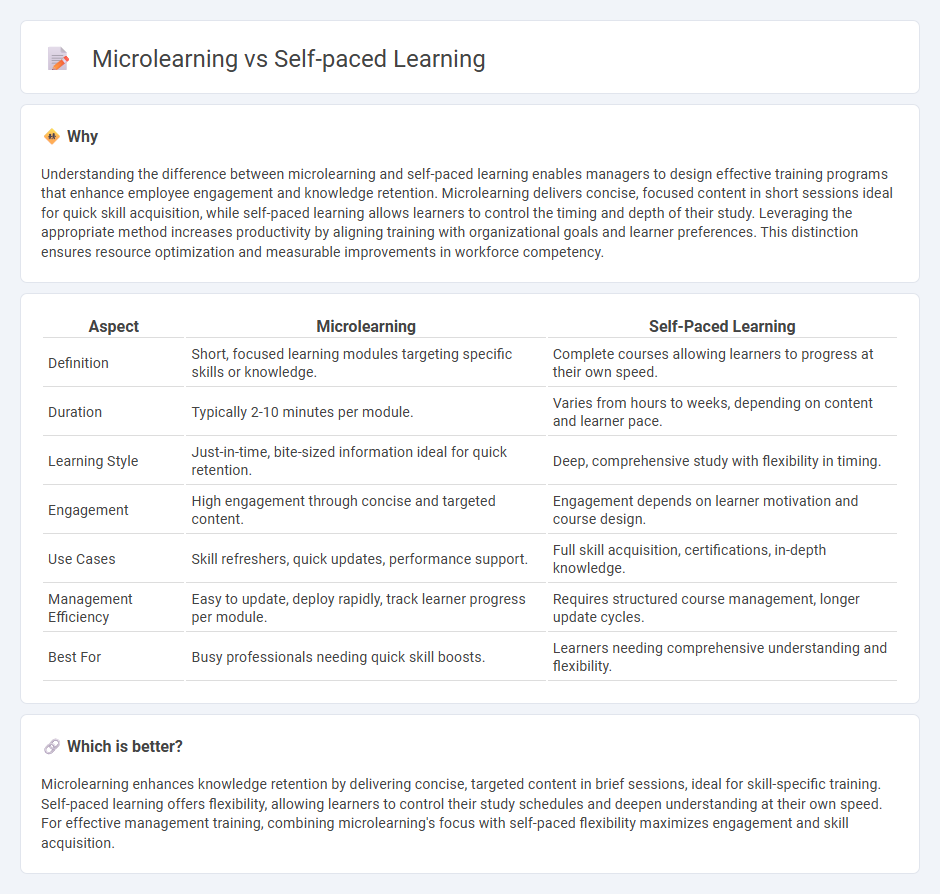
Microlearning delivers focused, bite-sized content ideal for quick skill acquisition and immediate application in corporate management. Self-paced learning offers comprehensive modules allowing learners to customize their schedule and explore complex management theories at their own rhythm. Discover how these methods can enhance your leadership development strategy.
Why it is important
Understanding the difference between microlearning and self-paced learning enables managers to design effective training programs that enhance employee engagement and knowledge retention. Microlearning delivers concise, focused content in short sessions ideal for quick skill acquisition, while self-paced learning allows learners to control the timing and depth of their study. Leveraging the appropriate method increases productivity by aligning training with organizational goals and learner preferences. This distinction ensures resource optimization and measurable improvements in workforce competency.
Comparison Table
| Aspect | Microlearning | Self-Paced Learning |
|---|---|---|
| Definition | Short, focused learning modules targeting specific skills or knowledge. | Complete courses allowing learners to progress at their own speed. |
| Duration | Typically 2-10 minutes per module. | Varies from hours to weeks, depending on content and learner pace. |
| Learning Style | Just-in-time, bite-sized information ideal for quick retention. | Deep, comprehensive study with flexibility in timing. |
| Engagement | High engagement through concise and targeted content. | Engagement depends on learner motivation and course design. |
| Use Cases | Skill refreshers, quick updates, performance support. | Full skill acquisition, certifications, in-depth knowledge. |
| Management Efficiency | Easy to update, deploy rapidly, track learner progress per module. | Requires structured course management, longer update cycles. |
| Best For | Busy professionals needing quick skill boosts. | Learners needing comprehensive understanding and flexibility. |
Which is better?
Microlearning enhances knowledge retention by delivering concise, targeted content in brief sessions, ideal for skill-specific training. Self-paced learning offers flexibility, allowing learners to control their study schedules and deepen understanding at their own speed. For effective management training, combining microlearning's focus with self-paced flexibility maximizes engagement and skill acquisition.
Connection
Microlearning and self-paced learning are interconnected through their shared focus on flexibility and learner autonomy, enabling individuals to acquire knowledge in small, manageable segments at their own speed. Both approaches leverage digital platforms to provide personalized learning experiences that cater to varying schedules and learning preferences. This synergy enhances retention and engagement, making them effective strategies in modern management development programs.
Key Terms
Autonomy
Self-paced learning empowers learners to control their educational journey by allowing them to set their own pace and schedule, fostering greater autonomy and personalized comprehension. Microlearning breaks content into small, manageable segments that promote frequent, focused engagement, enabling learners to efficiently master specific skills or topics independently. Explore more to understand how these approaches can enhance your autonomous learning experience.
Content Chunking
Content chunking in self-paced learning breaks down extensive material into manageable segments, allowing learners to control their study duration and pace. In microlearning, content chunking is inherently designed for brief, focused lessons that target specific skills or knowledge, enhancing retention and engagement. Explore more to discover how effective content chunking strategies can optimize your learning outcomes.
Flexibility
Self-paced learning offers unparalleled flexibility by allowing learners to control the timing, speed, and sequence of their study, accommodating diverse schedules and learning paces. Microlearning breaks complex topics into small, digestible modules, which enhances flexibility by enabling learners to engage with content in brief, focused sessions anytime, anywhere. Explore the benefits of self-paced learning and microlearning to find the best approach for flexible education.
Source and External Links
What Is Self-Paced Learning?: Benefits and Ways to ... - Self-paced learning allows learners to progress through course material at their own speed and schedule, offering flexibility and customization suited for diverse learning needs and busy lifestyles.
What is Self Paced Learning? Definition, Benefits and Tips - This learning style lets students control their study time, reducing test and social anxiety while enabling large group enrolment and personalized pacing.
On the effectiveness of self-paced learning - PMC - Studies show self-paced learning significantly improves memory and recognition performance compared to fixed-time study methods, especially when learners allocate their study time strategically.
 dowidth.com
dowidth.com